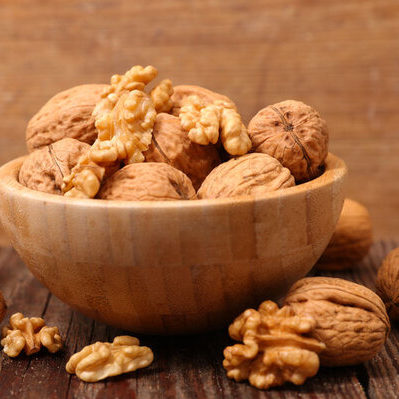
70742573 – walnut
Walnut
What is a Walnut?
A walnut is a dark-brown oval-shaped fruit with a brain-shaped edible sweet part inside. Its shell is usually hard and wrinkled. This food is a nut from the Juglans family.
The most popular species of walnut in the world are:
- Persian (Juglans Regia) also known as the English walnut
- Black (Juglans nigra)
- The butternut (Juglans cinerea)
- Japanese (Juglans ailantifolia)
Origin of walnuts
The origin of this nut can be linked to the first ancient account of walnut cultivation in Babylon (modern-day Iraq) around 2,000 B.C. Nonetheless, the archeological research in Neolithic sites in Southwest France has revealed walnut shells, implying that these nuts were being consumed in Europe 8,000 years ago. However, the breeding of a particular species of this nut is believed to have first begun with the ancient Greeks. The Romans later took the bull by the horn and cultivated walnuts around Europe and some outskirts of North Africa.
By the Middle Ages, walnut cultivation had reached the North of England. During the early 1800s, the Juglans Regia species was introduced to North America from England. It gained popularity, and thus, the name ‘English Walnut’ came into use. However, the Juglans nigra species are native to North America. They have similar characteristics to the English species of this nut, but many believe they are disregarded.
Nutrition
Walnuts are mainly made up of fats and a small amount of protein. A 30g serving size of this nut has the following nutrients:

This tasty nut also has lots of health benefits, such as preventing cancer, improving brain function, and lowering the risk of developing heart diseases, strengthening the bones, as well as reducing the risk of developing diabetes and obesity.
However, walnuts may also have their side effects. People who are allergic to this nut may go into anaphylactic shock. The phytic acid present in walnuts may also disrupt the absorption of minerals like zinc and iron from the body’s digestive tract, leading to mineral reduction.
Commercial Production
Walnuts are cultivated all over the world today. They require dedication and time, as the process of producing this fruit is not easy. A seedling takes five to seven years to grow into a full tree before it is ready for production.
The commercial production of this nut is divided into three steps:
Harvesting
When the dry green shuck starts to separate, mechanical shaking machines shake each tree roughly, propelling walnuts in tens of hundreds to land to the ground. These nuts are swept into windrows, so machines can pick them up for cleaning.
Processing
A hulling machine removes the outer green shuck, and the nut is mechanically dehydrated to an 8% moisture level. This prevents spoilage during storage.
Packing
In the third stage, the nuts are transported to a packing plant where they are grouped into two markets: in-shell and shelled.
For the in-shell market, after drying, the in-shell nuts are categorized into varying sizes in line with USDA standards. For the shelled market, the nuts are collected from storage and sent to a department responsible for mechanically cracking them. Next, the shelled materials are filtered. Then, kernels are sorted into different sizes, air-spilled from shells, and transferred through electronic color graders and shell sorters. Lastly, they are hand-sorted by trained professionals and certified for quality according to USDA standards.
China is the most significant producer of walnuts, providing for nearly half of the world’s supply. The USA is the second-largest producer in the world, responsible for nearly one-third of the world’s production. California is the top producer of this nut in the USA. The world’s walnut production from 2012 to 2019 reached a volume of approximately two million metric tons. In 2017, the global walnut market size was valued at $6.2 billion and projected to grow at a rate of 5.01%. The shelled segment holds the biggest share.
Application
Walnuts can be bought from the market in their shell, unshelled (cut up or ground), or in a processed form. When these nuts are not stored properly, fungi and insects can make a fest out of them. Walnuts are best stored below 77°F with low humidity. Storing them above the recommended temperature would lead to quick spoilage. If you need to consume them within a few months, store them in an airtight container in the refrigerator. Should you need to keep them for at least a year, store them in a freezer and make sure they are kept in a cool, dry, and dark environment.
Walnut recipes
These nuts are great as snacks and ingredients in many dishes. Here are some popular recipes:
- Stuffed Celery with Cream Cheese and Walnuts
- Walnut Snowball Cookies
- Walnut and Roasted Tomato Guacamole
- Quick Frosted Walnuts
- Slow-Cooker Maple-Walnut Carrots
FDA Regulation
The FDA classifies walnuts as a raw agricultural commodity and regulates their growing, harvesting, packing, and handling. It also classifies walnut oil as a dietary supplement, regulating the reference amount consumed per eating occasion. Furthermore, the FDA categorizes these nuts as a tree nut and peanut product, offering their requirements for standardization. The FDA also labels these nuts as a natural flavoring agent and a food component for use as a food additive permitted for direct human consumption and as a substance for use as a component of coating for a non-direct food additive.
References
Atli, Arnarson. “Walnuts 101: Nutrition Facts and Health Benefits.” Healthline.com, Healthline Media, 26 Mar. 2019, www.healthline.com/nutrition/foods/walnuts.
“History of Walnuts.” fruitsandnut.ie, Fruit and nut blog, www.fruitandnut.ie/walnuts.html.
“How Walnuts Are Grown.” Walnut.org, California Walnuts blog, 19 Aug. 2020, walnuts.org/about-walnuts/how-walnuts-are-grown.
“CFR – Code of Federal Regulations, Title 21.” Accessdata.fda.gov, U.S Food & Drug Administration, 1 Apr. 2019 www.accessdata.fda.gov/scripts/cdrh/cfdocs/cfcfr/CFRSearch.cfm.
